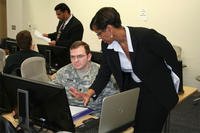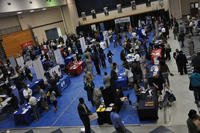There's bad news for America's children: More than half of education specialties are suffering shortages of teachers and other professionals. But this situation is good news for aspiring teachers, who with talent, hard work and training can land a job in almost any subject niche or grade level.
For the first time in the 25 years that the American Association for Employment in Education (AAEE) has conducted its survey, none of 63 education specialties has a staff surplus. While there's a good balance of supply and demand in one-third of specialties, the other two-thirds report "considerable shortage" or "some shortage."
Longtime Shortages Continue
Specialties that have lacked adequate staffing for many years continue to endure the most serious shortfalls, according to a 2001 AAEE survey. Math, physics, chemistry, bilingual education and English as a Second Language (ESL) all have a "considerable shortage."
All of the 10 other specialties in this top shortage category fall within one area: Special education. From teachers for the visually or hearing impaired, to specialists in learning disabilities or emotional/behavioral disorders, demand far exceeds supply.
With math and the hard sciences, the shortage is driven by the great disparity in pay between teaching and corporate jobs. A physics teacher might start at $30,000 and hope to earn $45,000 in 10 or 15 years; a corporate scientist could start at $50,000 and eventually break into six figures.
Due to acute teacher shortages, many primary and secondary schools have created special programs to woo talented professionals in fields such as mathematics. At Iowa State University in Ames, a new training program focuses on easing the path to certification for mathematicians. "This is a perfect option for someone leaving industry or government service who's seeking an avenue into teaching," says Kevin Brown, a spokesman.
Bilingual and ESL Teachers in Short Supply
The dearth of bilingual and ESL teachers is partly attributable to a demographic gap between schoolteachers and their students.
"Teachers of color make up around 14 percent of all current K-12 teachers," says a report from Recruiting New Teachers Inc., a Belmont, Massachusetts-based national clearinghouse. "However, children of African American, Hispanic and Latino, Asian and Native American descent make up 36 percent of the student population," the report adds. Although many people of color are native English speakers, as a group, they are more likely than Caucasians to have another language as their mother tongue.
Administrators and Creative Teachers Needed
Aspiring teachers with a creative bent should find cause for optimism in the AAEE report -- there was "some shortage" of vocal and instrumental music teachers in 2001. In art education and theater, teacher supply is currently in balance with school demand.
For those willing to take on the extraordinary challenges of educational administration, there's room for advancement. School superintendents and principals at all levels -- elementary, middle and high school -- are in "some shortage."
Elementary, Middle and High School Demand
Primary and secondary schools have traditionally churned out plenty of teachers for the elementary grades, while middle and high school teachers have been in shorter supply. This trend is expected to continue. Through 2008, employment of secondary school teachers is expected to grow faster than jobs in elementary education, according to a Bureau of Labor Statistics report.
"Sometimes the motivations of people looking at teaching in elementary, middle or high schools are different," says B.J. Bryant, executive director of the AAEE. "Very often, the high school teacher is more content-driven than an elementary or middle school teacher, who may be interested in working with a particular age [group]."
This article originally appeared on Monster Career Advice: http://career-advice.monster.com/.






















